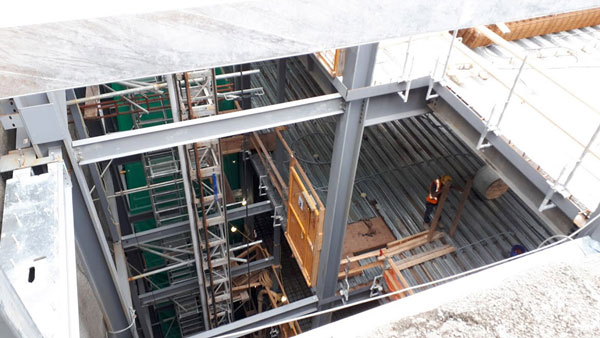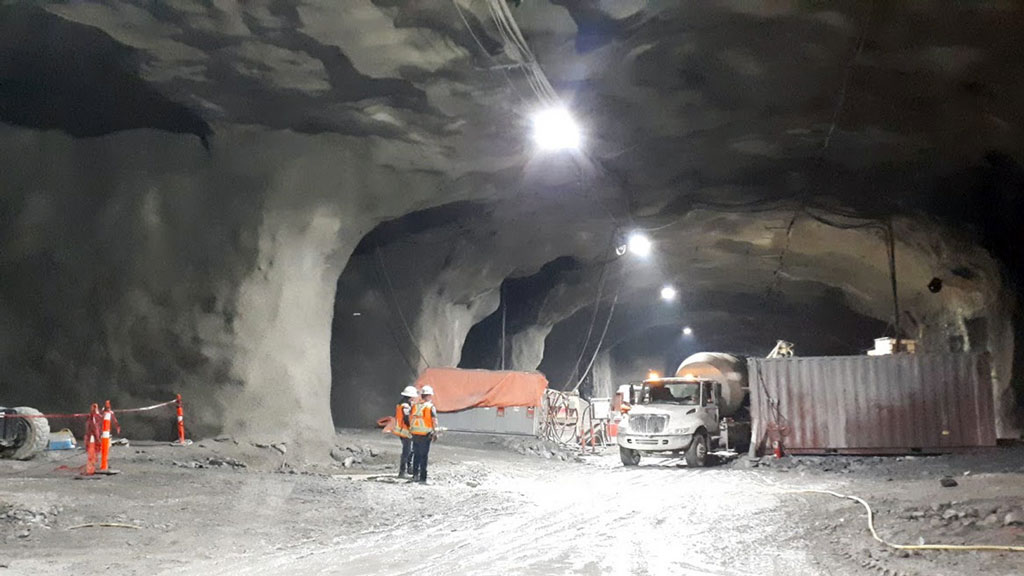Down, down, down we descend in a construction elevator through a grid of structural steel in a shaft that will eventually become the second deepest subway station in North America.
The station, Edouard-Montpetit, nestled on the northern flank of Montreal’s more than 200-metre-high Mont Royal, colloquially “the mountain,” already exists for the city’s subway system or Metro.
But since opening 35 years ago, residents in the municipal borough that surrounds the station have complained that to get to downtown Montreal they have had to circuitously take two or three subway lines, adding almost a half hour to the journey.
This, when immediately below the station an existing commuter train line for decades had run through an underground tunnel reaching downtown in about 10 minutes.
Come 2024 the residents’ wait will be over. That’s because the shaft we are travelling through is part of a complex that will drop 72 metres, linking the Metro station to that one-time commuter train line.
Only now, that commuter line will be transformed into the city’s new Reseau express metropolitain (REM), a 67-kilometre, 26-station light rail system that will link downtown Montreal to its northern, southern and western suburbs as well as Pierre Elliott Trudeau International Airport.
And, for long-suffering residents, travel under the mountain between Edouard-Montpetit and McGill — the most immediate downtown station — will now take less than three minutes.
“The neighbours will finally get quick access to downtown,” station project manager Jean-Philippe Pelletier said. “It’s a huge game changer for the transit system.”
Construction of the Edouard-Montpetit station began three years ago. One of three entranceways to the existing Metro station was demolished to make way for the REM portal. Then 500 mini dynamite blasts were required to blow away 25,000 cubic metres of intrusive rock, the kind that makes up the bulk of Mont Royal, part of an ancient volcanic complex.

“It’s an old volcano. It’s really dense rock,” Pelletier said.
Blasting required surgical precision because crews wanted to provide the least disruption to the densely populated neighbourhood above.
For larger areas of the shaft as much as 100 to 300 cubic metres were detonated at a time and for smaller areas, like pedestrian tunnels and passenger waiting platforms, 20 to 250 cubic metres.
Detonations usually took place a couple of times a day between 7 a.m. and 3 p.m. for “all the courtesy that we could give,” Pelletier said.
That said, neighbouring elementary school children “were really excited about the shake and movement of the ground,” he chuckled.
Rock excavation finished last November.
Accordingly, station architects have included two visual features for passengers, swaths of the original intrusive rock to connect with Mont Royal’s geology. The rest of the rock, all through the shaft and concourses, has been covered with shotcrete before interior architecture finishes are installed.
The construction elevator descends 56 metres to what will be the mezzanine concourse level connecting the Metro Blue Line and the REM. From there passengers will descend the remaining 14 metres to the REM platforms. Five high speed elevators will whisk passengers to street level in 20 seconds.
“It’s really high capacity because it’s too high to have stairs (except for emergency),” REM spokesman Jean-Vincent Lacroix said.
The Edouard-Montpetit station will be the second deepest, the equivalent of 20 storeys, in North America, doubling the depth of the Metro’s Charlevoix station, currently Montreal’s deepest. North America’s deepest transit station is Washington Park in Portland, Ore. at 79 metres.
Currently the mezzanine, flanked by the massive structural steel grid, is an uneven surface of aggregate as crews prep openings for smaller connecting passenger tunnels, escalators and stairways.
The structural steel complex won’t hold only the elevators but electrical equipment and one of two ventilation shafts. The other will be located at the mountain’s downtown or south portal at the McGill station. Previously there was only one shaft, but former commuter trains didn’t stop here and weren’t as frequent as the up to 2.5-minute headway between future REM trains.
“With the REM, we’re going to have up to 10 (two car) trains down there so it was required to build another shaft,” Pelletier said.
From the mezzanine level we walk down a temporary set of construction stairs to, finally, the REM train level itself.
This is the original more than 100-year-old commuter train tunnel, where for decades Montrealers commuted from northern suburbs into downtown on conventional trains. REM work crews took three months to rip up those tracks and now the surface is muddy prior to the eventual installation of a new drainage system, tunnel divider, tracks and signals.
While excavations have widened the tunnel for 80 metre pedestrian platforms, the original rounded tunnel roof can still be seen. Meanwhile several cement mixer trucks are lined up at intervals undertaking spot pours.
Mixer trucks in a tunnel? About 1.5 kilometres north, at the existing Canora commuter train station, which is also being converted for the REM, there’s a ramp that allows trucks to enter the tunnel. But trucks often stay in the tunnel, loaded from above, and move back and forth for the spot work.
The $6.5 billion REM, Montreal’s biggest transit project in 50 years, is being financed in part by the Caisse de depot et placement du Quebec (CDPQ), its operator and principal owner through CDPQ Infra. Other major funders are the Quebec and Canadian governments.
Engineering and construction is being carried out by Groupe NouvLR which includes SNC-Lavalin, Dragados Canada Inc., Groupe Aecon Quebec Ltee, Pomerleau Inc., EBC Inc.











Recent Comments